There have hardly been more important devices throughout the long history of human civilization and science that helped us better understand the world than the microscope. This intricate gadget allowed us to study invisible particles and organisms that would otherwise remain completely foreign and unknown to us. In the modern day, a microscope is among the most crucial of tools in any laboratory, medical institution, and even school. It has remained a fascinating piece of machinery that continues to amaze people of all age groups and all backgrounds since having an insight into the vast microscopic world is important for an individual to better understand the universe.
A person’s fascination with science and anything relating to learning new things starts to happen in childhood years, around the time when more specific school subjects enter the picture. Middle school would be the best guess but every child is different. Some of them develop lifelong habits and hobbies at this time and for those who like to explore and learn, there are not many better things to own than a microscope. Adults who enjoy looking through the lenses probably have at least one personal microscope at home they utilize in their free time.
If these are things you find fascinating and interesting, perhaps it is time for you to but one for personal home use. However, buying such equipment comes with a lot of things worth thinking about and evaluating. There are many intricate parts to a microscope that you have to know about, but the most important factor is the actual use. What do you need it for and how serious are you about this? To help you with your decision we decided to write this article and determine which brand should you get for home use. Moreover, we will evaluate your options in terms of different types and models. Learn more by visiting https://www.microscopeclub.com/.

Source: Hi Valley Chemical
Contents
Compound and Stereo
The most basic division when determining the right model for your personal home use is whether you need a compound or a stereo device. Compound versions are used for the smallest of specimens like bacteria, blood samples, and anything else that you can barely catch with your eye. These have higher levels of detail and allow 1,000 times magnification. Monocular, binocular, and trinocular varieties exist.
On the other hand, stereo microscopes are used for larger specimens you mean to magnify like insects, bugs, gems and rocks, or leaves. These still allow a lot of magnification but not nearly as much as the compound models. They need and use less power and are at least binocular. They can usually be disassembled and have their parts changed, contrary to the compound types that are integrated. Both of these versions come in various price, quality, and design ranges sod depending on what you need you can choose whichever seems like the best fit for your specific requirements.
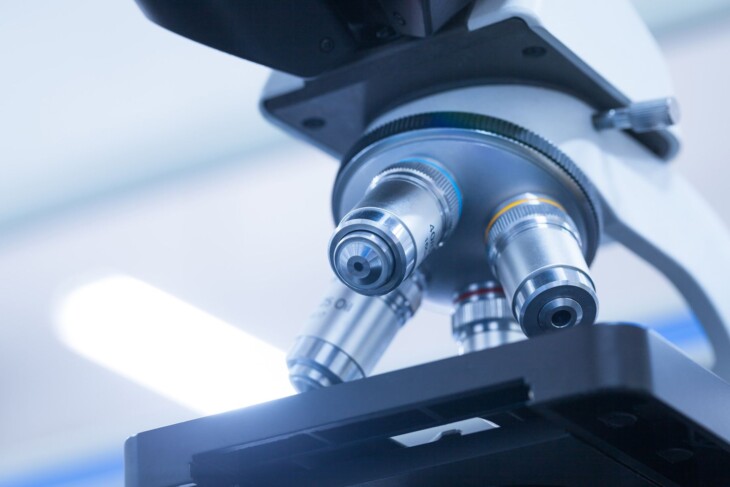
Source: AIA | Vision Online
Lighting
The light your microscope gets can arguably be described as the most important thing apart from the magnification power. There are five ways it can get the necessary light including tungsten/incandescent, halogen, fluorescent, and LED light, or mirror. Each has its own ups and downs and different model go for different solutions. Tungsten light is yellow, produces the most heat and has the lowest lifespan, and they are also the hardest to replace. LED white light produce the least heat and have the best lamp life, making them increasingly more popular solutions. Halogen (yellow) and fluorescent (white) bulbs produce low to medium heat and have slightly above average lifespans.
Best Microscopes to Get
Let us now finally determine the best models and brands out there on the current market so that you can finally browse for your best pick.
1. Bresser Biolux NV 20x-1280x – $149
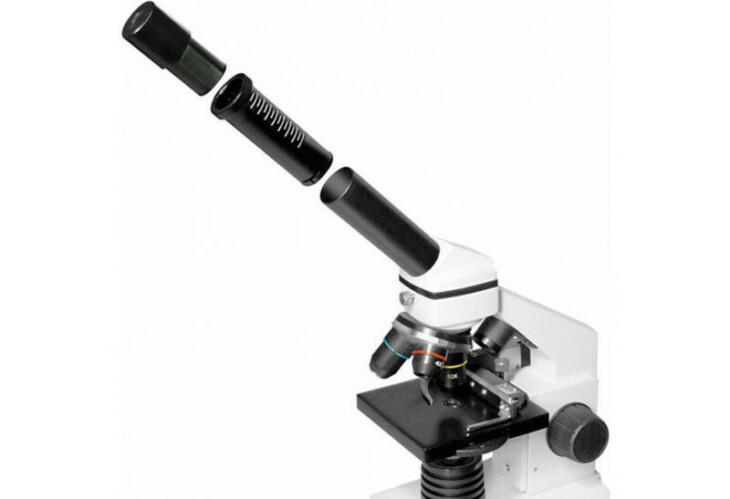
Source: Photospecialist
If we were to give you the best model for beginners, this would be it. The model has an HD USB camera built in and it is battery powered with 3 AA batteries (included) needed. There are 5x and 16x eyepieces and 4x, 10x, and 40x objective lenses included. The model weighs 1100 grams and it measures at 150 x 105 x 270 mm. It has an LED lamp. The only downside would be the fact it only supports Windows OS.
2. Celestron CM800 Compound Microscope – $108
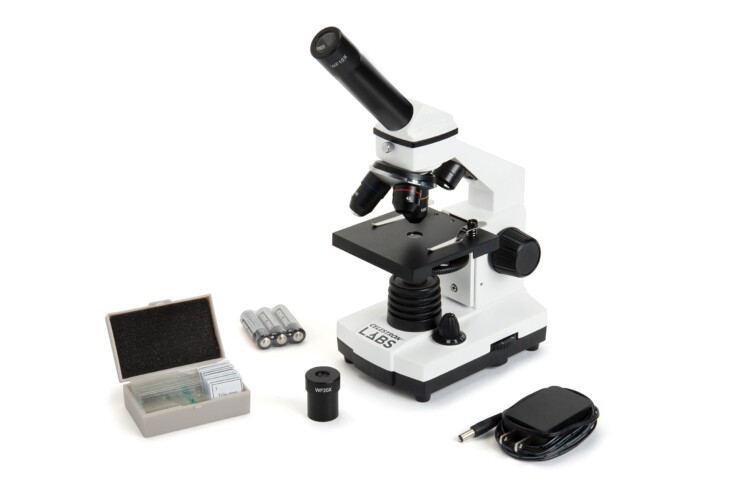
Source: Desertcart
The first model was the best for beginners while this one would be the best value option you can find at the moment. It is certainly a lab-grade model and therefore more than useful for both the students and amateur enthusiasts. The construction is all metal and it weighs 1430 grams. Dimensions are 55.9 x 40.6 x 35.6 cm and there is an adjustable LED lamp. Eyepieces are 10x and 20x while the objective lenses include 4x, 10x and 40x. The three AA batteries are included in the box.
3. Celestron FlipView – $189
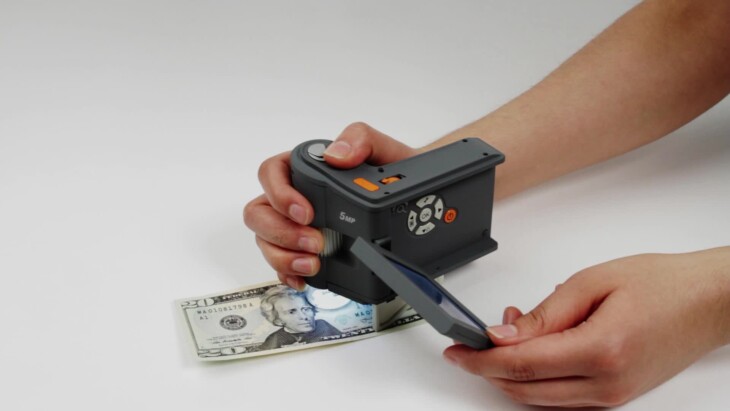
Source: Amazon UK
For something more on the modern and mobile side, check out this innovative model with a flappable 3” LCD screen instead of a traditional eyepiece. Magnification is pretty low, only 10x to 120x, but this is a completely different type of tool. It is extremely portable and only weighs 317 grams. It easily links to computers and it has a 2592 x 1944 resolution camera. Like most modern gadgets, it runs on a rechargeable lithium ion battery.
4. Learning Resources Geosafari Micropro – $32
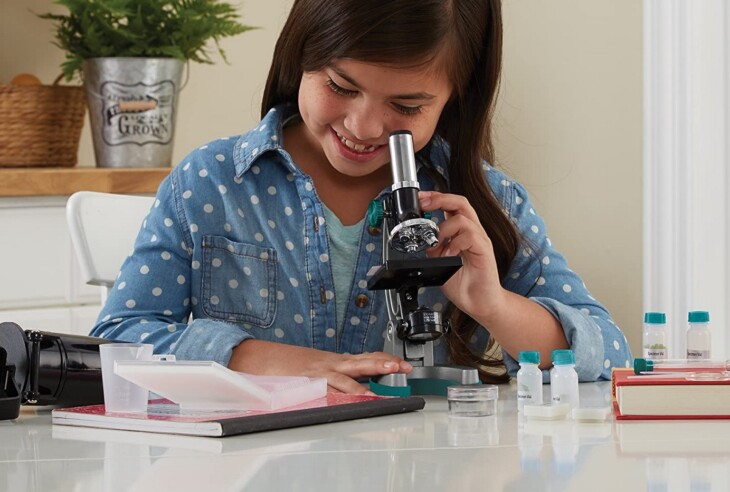
Source: Amazon.com
In case you need something for the up-and-coming scientist in your home during their childhood years, you will definitely want to check out this model that is the perfect option for kids. It is quite cheap and has all the sciency accessories goodies to make your child the best scientist in school. Magnification is quite fair at 50x to 600x and the eyepieces are 10x and 20x. It runs on 2 AA batteries which are not included. Dimensions are 9.7 x 25.4 x 33 cm and it only weighs 780 grams. It is both a science toy and a true piece of lab equipment that your child will be hooked on. Tubes, tweezers, pipettes, scalpels, spatulas, and petri dishes are all parts of this all-in-one science lab kit that will make your kid engaged for years.
5. Levenhuk Rainbow 50L – colorful, easy to use, best starter microscope, magnification 40x to 800x, objective lenses 4x, 10x and 40x, 2 AA batteries are included, 18 x 26.9 x 40.4 cm, 2740 grams.
6. Dino-Lite AM4113T USB Microscope, support for Windows and Mac, magnification 10x to 220x, 10.5 x 3.2 cm, 105 grams.
7. AmScope T580B Compound Trinocular Microscope, best professional microscope, anti-mold surfaces, magnification 40x to 2000x, eyepieces 10x and 20x, objective lenses 4x, 10x and 40x, 21 x 18 x 10 inches, 8140 grams.
